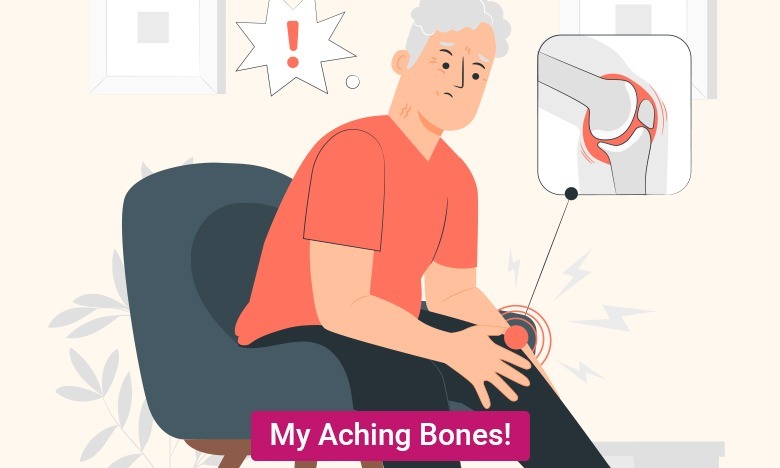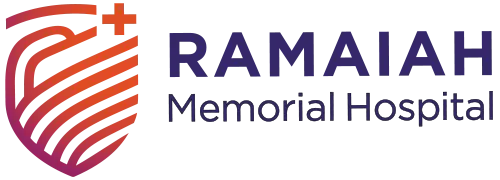My Aching Bones!

Mr. Phaneendra can still remember the day he experienced his first real injury. He is a 67 year old retired employee, from the banking sector, who retired as a senior manager. Paradoxically, his injury happened, right outside his bank, from which he retired. While climbing down the stairs of the exit, on a rainy day, he missed one step, landed on his hands to break the fall.
The next thing he vividly remembers is the “crunch” he heard in his right wrist and the numbing pain, from which he almost blacked out.
He was treated at Ramaiah Memorial Hospital. Where the orthopaedics team, not only treated his fracture emergently, but also, investigated and diagnosed him with severe osteoporosis. A multispecialty and multimodal approach was used to treat his underlying osteoporosis – future-proofing him against such injuries.
WHAT IS OSTEOPOROSIS?
This injury was a consequence of trauma. But there are many individuals who suffer from non-traumatic fractures, from osteoporosis.
Osteoporosis, is a condition of low bone quantity, causing bones to become thin, weak and brittle. This condition is not life threatening, but impairs quality of life, leading to debilitating fractures of the hip, spine and wrist along with various complications.
Osteoporosis, really is invisible. There are no obvious signs when a person develops osteoporosis, and importantly, they don’t feel any different. Until they break a bone. Then it becomes obvious that something has happened.
Can you believe, that some of those suffering from severe osteoporosis can have a fracture, from trivial trauma such as coughing, sneezing, or tripping after losing balance?
Most of us have seen an old lady or man with a severe curved spine or upper back walking down the street at some point. This rounding of the back ( kyphosis or “dowager’s hump) is a sign of advanced osteoporosis and can be a consequence of compression fractures of the vertebrae.
Complications from an osteoporotic fracture may significantly impact a person’s daily activities and quality of life.
YOUR BONES
To understand how osteoporosis affects your bones, it’s helpful to know how they work.
Although we often think of them as dry and lifeless, bones are living tissue. They’re made of the protein collagen and are strengthened with the mineral calcium phosphate. They’re constantly changing throughout life. Specialised bone cells (osteoblasts) create new bone, while others (osteoclasts) break down and remove old bone. The rate at which this occurs changes as we age.
From birth to about 25 years of age, you build more bone than you lose. Your bones are not only getting bigger as you grow, but they’re also developing their density. This determines how strong they are.
From about 25 to 50, your bones break down and rebuild at about the same rate. Your bones are at their strongest.
After about 50 years of age, you break down more bone than you rebuild. While this means everyone will experience some bone loss as they age, it doesn’t mean everyone will develop osteoporosis.
Women commonly experience a period of rapid bone loss after menopause. This is due to a drop in oestrogen levels.
RISK FACTORS
Some of the risk factors for osteoporosis include
- Age
- Family history
- History of previous fracture
- Race
- Vitamin D deficiency
- Low body mass index
- Excessive alcohol intake and smoking history.
- Certain medications like steroids, antacids, and antidepressants can increase fracture risk.
- Medical conditions such as rheumatoid arthritis, lupus, seizures, inflammatory bowel disease or thyroid disorder
CALL TO ACTION
- In women, osteoporosis accounts for more days in hospital than breast cancer, heart attack, diabetes, and many other diseases.
- In men, fracture risk is up to 27% higher than the risk of prostate cancer.
- Worldwide, one in three women and one in five men aged 50 years and over will sustain a fragility fracture due to osteoporosis in their remaining lifetimes
WORLD OSTEOPOROSIS DAY is celebrated on October 20th, with the underlying campaign “BUILDING BETTER BONES throughout life” this year with the theme to prevent SECONDARY FRACTURES.
ASSESS RISK OF FRACTURE
If you’re concerned that you may have osteoporosis or be at risk of developing it, you should see your doctor.
- Obtaining a thorough clinical personal and family history to asses risk factors.
- Performing bone density testing (DXA). A DEXA scan is short and painless. While you lie on your back on a padded table, a scanning arm passes over your body to take images of your hips, spine, and in some cases, the forearm. It takes about 15-30 minutes. A report is sent to your doctor, who will discuss the results with you
- Obtaining blood work to check for calcium, vitamin D, parathyroid and thyroid levels
LIFESTYLE CHANGES
Once this assessment is completed, physicians at Ramaiah Memorial Hospital, will discuss lifestyle changes to help prevent this bone disorder. A few of these tips include:
Avoid bone-damaging habits
- Stop smoking today!
- Maintain a healthy BMI
Move your bones
- Bones, like muscles, get stronger when you use them. Exercise helps build bone in children and teens as they grow, and helps maintain bone in adults.
- The best types of exercises for bone health are weight-bearing and muscle strengthening. Lift, push, run, jump, and ‘step’ your way up to stronger bones!
- Overall, most people should aim to exercise for 30 to 40 minutes three to four times each week, with weight-bearing and resistance exercises in the program.
- People with osteoporosis benefit from a targeted exercise plan which also includes exercises to improve balance and posture. Exercise should be tailored to your situation and abilities.
- Targeted exercise plays a crucial role in rehabilitation post-fracture, helping to reduce pain, improve physical function, and improve quality of life
- Physiotherapists can give expert advice and develop tailored exercise regimens post-fracture.
Ensure a bone-healthy diet
- Eat well! A bone-healthy diet is a balanced diet with adequate intake of calcium, protein, vitamin D, vitamin K and other nutrients.
- Nutritional needs change with age. For example, young people who are still growing and women after menopause need higher calcium intake.
- For most people, a balanced diet provides all the nutrients needed.
However, people who cannot get enough calcium from their diets, or vitamin D from exposure to the sun, may need supplements for optimal bone health.
WHAT ABOUT MEDICATIONS?
Sometimes women and men may develop worsening bone density despite their participation in good lifestyle modifications and may require medications to increase their bone density and strength. Some of these medications aim to help build bone mass and increase bone strength and other medications aim to prevent further bone loss.
Currently bisphosphonates, denosumab, teriparatide and abaloparatide are some options for treating osteoporosis. No therapy is permanent.
Every person is different and must discuss the options with his or her physician and evaluate the comfort level with the drug side effect profile before making a final decision.
Keep in mind that NOT TREATING osteoporosis can be risky and may lead to disability.
At Ramaiah Memorial Hospital, we hope that with more education about this public health concern, people will empower themselves to take measures to improve their bone health!
TAKE CARE OF YOUR BONES!!
Dr. Shravan Y.C. Achar
Department of Orthopaedics


